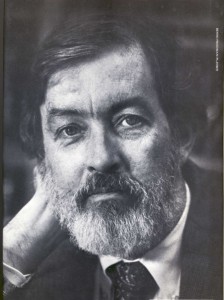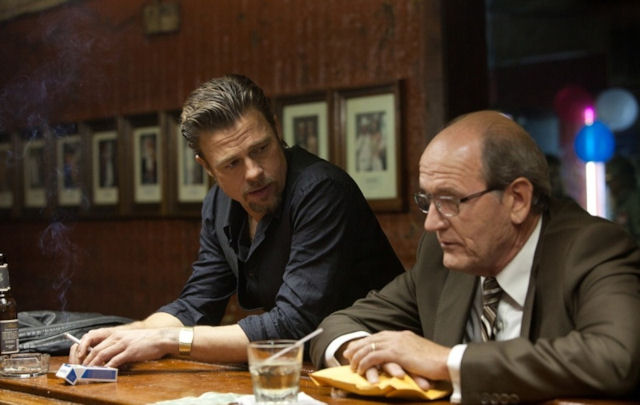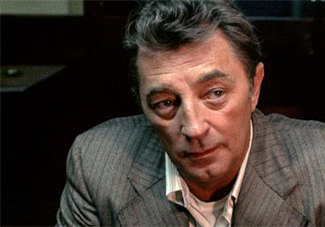Short Fuse Review: Killing George Higgins Softly
The Friends of Eddie Coyle was simply too good a movie, perfect, in its way, and the director of Killing Them Softly wants to avoid comparison.
By Harvey Blume.
Midway through Cogan’s Trade (1974), the George Higgins novel from which the film Killing Them Softly is too loosely adapted, Jack Cogan, one afternoon, drinks off a “stein of dark in Jake Wirth’s.” Not too many guys know Cogan nor, given his area of expertise, would wish to, but Mitch is up from New York at Cogan’s invite to talk business. Some drinks, mostly Mitch’s, later, Cogan discourses about what his wife, Carol, has said to her mother about the fact that she, Carol, unlike her sisters who have many, will not be having kids: “Ma, Aunt Carol’ll have to be the limit, is all. You can’t always do the things you’d like to do.”
Mitch chimes in: “You can’t never do the things you’d like to do. Never. Every time you do, you get inna shit.”
Jacob—Jake, to Cogan—Wirth’s is across the way from Tufts Medical Center, which gives the next sentence context. “The waiter, having served the interns and technicians twice, brought the drinks to Cogan and Mitch.”
Higgins’s cons, ex-cons, scuzzballs, and sad sack lowlifes do not lack for prickly pride. Mitch, seeing himself twice overlooked by the waiter in favor of the Tufts crowd, complains: “Where do you have to go for these [martinis]?” The waiter—”an elderly man, bent in the formal uniform”—looks blank. Mitch pushes it: “I said: Where do you have to go for these things?. . . I know it’s some place outa the building, here, it’s obviously gotta be. You maybe even got to walk a couple blocks, take a cab or something. I was just wondering.”
When the martini does arrive, and the waiter asks if it’s okay, Mitch says, “Well, as a matter of fact, no, it’s mostly evaporated by the time it gets here.”
You have more, in this bit, of George V. Higgins—his milieu, style, argot, and allure—than you’ll find in all of Killing Them Softy. If Jake Wirth’s doesn’t nail down the general locale for you, references in Cogan’s Trade to Commonwealth Ave., Harvard Sq., Somerville, and several outlying suburbs can’t fail to. We know, roughly, what year it is because the talk is of the “Broons” and Bobby Orr.
We are rooted thus in time and place as we never are in Killing Them Softly. Of course, in adapting the book for film, director Andrew Dominik is by no means obligated to reproduce a Boston setting. The movie was in fact shot in New Orleans. But why then the heavy Boston accents, erratic, to be sure, since actors tend to slip in and out of them? And if we’re in the South, as the scenery indicates, why no Southern accent? More disconcerting is that Dominik doesn’t seem to know what time it is or what time he means it to be. Killing Them Softly opens with a speech by Barack Obama, as seen on television. Further on, we hear G. W. Bush, talking up the need for what will become TARP. At the conclusion, we’re back to Obama. But the shot of a chalk menu in a bar belongs to completely different era, listing a full meal at $5.95, as if, for the duration of this lunch anyway, we are back with the Broons and Bobby Orr.
The movie’s slipperiness with regard to setting—its approach-avoidance to Boston—is especially peculiar given that, at least since The Friends of Eddie Coyle (1973), the film made out of Higgins’s first novel, Boston has been a preferred, if not a default, venue for stories, like this one, seeking to suggest blue collar authenticity and grit. Maybe that’s precisely why Dominik plays pussyfoot with Boston. The Friends of Eddie Coyle was simply too good a movie, perfect, in its way, and the director of Killing Them Softly wants to avoid comparison. He prefers to let his film float in time and space. The problem is that, like the martini Mitch gets at Jacob Wirth’s, Killing Them Softly is, after all that floatation, “mostly evaporated by the time it gets here.” Wanting to make use of George Higgins while keeping The Friends of Eddie Coyle at bay may explain why Cogan’s Trade, a perfect title, is dropped in favor of the irrelevant Killing Them Softly.
The Friends of Eddie Coyle soaked up Boston griminess much the same way Taxi Driver (1976) soaked up New York City’s, even if the former is not as extravagantly violent as the Scorcese film. Violence in The Friends of Eddie Coyle is concentrated on the scene in which a hangdog Robert Mitchum, drunk on beers imbibed—sorry—at a “Broons” game takes a bullet to the brain. Killing Them Softly tries to make up for what it lacks, which is most if not all of what Higgins has to offer, by, on the contrary, highlighting violence. Much of it is boilerplate—pain and blood, more pain more blood, and, for variety, some vomit. One killing is beautiful in its way, a slow motion shot of blood mixing like paint drippings with glass from a car window in the act of shattering.
One scene in the film musters its own genuine intensity: it depicts Brad Pitt (as Jack Cogan) putting Frankie (played ably by Scoot McNairy, except when he doesn’t remember whether he’s supposed to talk like it’s Somerville) through a number of deadly verbal snares, which will eventually ensure that Frankie helps out with what Cogan is really good at. The scene is reminiscent of the one in the film Glenngarry Glen Ross in which Al Pacino makes the purchase of a bit of real estate seem existentially unavoidable to a customer. It is no wonder that David Mamet has praised and studied George Higgins.
If Killing Them Softly brings Higgins back that would be its virtue. One novel besides I’d recommend—not having read the dozens—is Outlaws (1987), in which Higgins extends his range. Boston is at the center, to be sure, but there’s also London and New York. The story, which begins in 1970 and concludes in 1986, involves cops and lawyers—the indigenous population of a Higgins book— but, crucially, violent left-wingers held over from the sixties, plus the crème de la crème of cultured high society. Don’t bet too soon on who the eponymous outlaws are.
What Higgins, who died in 1999, was famous for, of course, was dialog. It’s as if, throughout his oeuvre, he aimed to demonstrate Noam Chomsky’s thesis that what sets human speech apart from animal communication is its recursiveness, the way it coils around itself, so that you can tell a tale by having someone say all the things everyone said to everyone else all the way through. Higgins’s voices are full of other voices. He was a master of the quotation mark, the inner, deeper, and ever more interior quote. Events—murders, marriages, fishing trips, jail, break-ins, cancer, trips to Florida with a car full of crapping stolen dogs—are perturbations, often funny, in the ongoing wash of talk. There was a time there was so much Higgins that he was taken for granted. That was a mistake.
Tagged: Brad Pitt, Cogan's Trade, George Higgins, Killing Them Softly, Outlaws, Short Fuse



